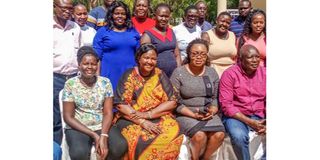Why beaded ornaments are ruining Turkana girls’ education

Forum for African Women Educationalists - Kenya officials, women's rights organisations representatives, and policymakers after a session to validate a report on barriers to girls' education in Turkana.
What you need to know:
- Report says child marriage is widespread in Turkana West among girls aged between 10 and 18, with those in the 15-18 bracket accounting for 80 per cent of early marriages and teenage pregnancies.
- Beaded girls perceived as gold or “banks where family incomes are saved” until suitors emerge, the findings show; dowry is a source of wealth.
Early marriages and teenage pregnancies are the top barriers to girls’ education in Turkana County, the Forum for African Women Educationalists - Kenya (Fawek) has said.
A report by Fawek has revealed that the situation is worsened by the beading culture that girls adopt at a tender age. This was based on a study that focused on girls’ education in crisis and humanitarian settings and targeted vulnerable refugee and host community girls in Turkana West that had 15,655 boys and 12,373 girls last year at 63 primary schools.
Fawek chief executive officer Teresa Otieno said most parents are unaware of the benefits of educating their daughters.
"With negative perception of education, those who try to take girls to school after intervention of local administrators take them when they are overage. While in class with their beads around their neck, they don't concentrate on studies as their focus culturally remain getting married, hence easily dropping out," Ms Otieno said.
The report indicated that child marriage is widespread in the sub-county among girls aged between 10 and 18, with those in the 15-18 bracket accounting for 80 per cent of early marriages and teenage pregnancies.
Gold/bank
The beaded girls in the host community are perceived as gold or “banks where family incomes are saved” until suitors emerge, the findings show. Dowry is a source of wealth.
In comparison, child marriage was found to be more prevalent in the host community than in the refugee camp as indicated by 51.9 per cent of the respondents.
Teachers interviewed observed that pregnant girls drop out of school or come back as married and with a child or children. They said 80 per cent of girls in secondary schools in the host community are either married or have children.
Mr Levy Indiasi, an education official from Turkana West, said when schools closed down as part of Covid-19 containment measures, 75 schoolchildren became pregnant.
Mr Indiasi said many parents neglected their responsibilities, leaving girls to fall prey to men who gave them money to buy sanitary towels and food in exchange for sex.
He said protection of girls from child marriage is currently being coordinated by the Area Advisory Committee (AAC), under the department of children. Local chiefs are involved and child marriage cases are reported to police.
It was established that in 2020, 16 cases were reported. Among them, a 60-year-old man was arrested, charged in court, convicted and jailed for marrying a 13-year girl.
Way forward
Fawek recommended that peer education, community dialogue, parental guidance and enforcement of the rule of law are some of the measures that must be put in place to reduce early marriages. It asserted that elimination of child marriages would have many benefits to girls, families, communities, and the county as a whole.
The benefits listed include empowerment of girls, better health and well-being, improved education attainment, increased labour force participation and incomes.
Through partnership with Equal Measures 2030, they are seeking to improve learning outcomes for girls in the county through data driven advocacy for targeted women rights organisations, key policymakers, United Nations agencies and education stakeholders.
Girl Child Network official Annie Arot said that as a women’s rights organisation operating in Turkana, they have lacked data on specific barriers to girls’ education.
"The data by Fawek will be critical to our planning and execution of targeted and evidence-based intervention on how we will eradicate or minimise barriers to girls’ education. It will also help us keep track of our activities," Ms Arot said.
Other barriers highlighted were drug abuse, child labour, cattle rustling and natural disasters like floods and drought. Politicians were advised to make girls’ education a key agenda by integrating it in their manifestos.





